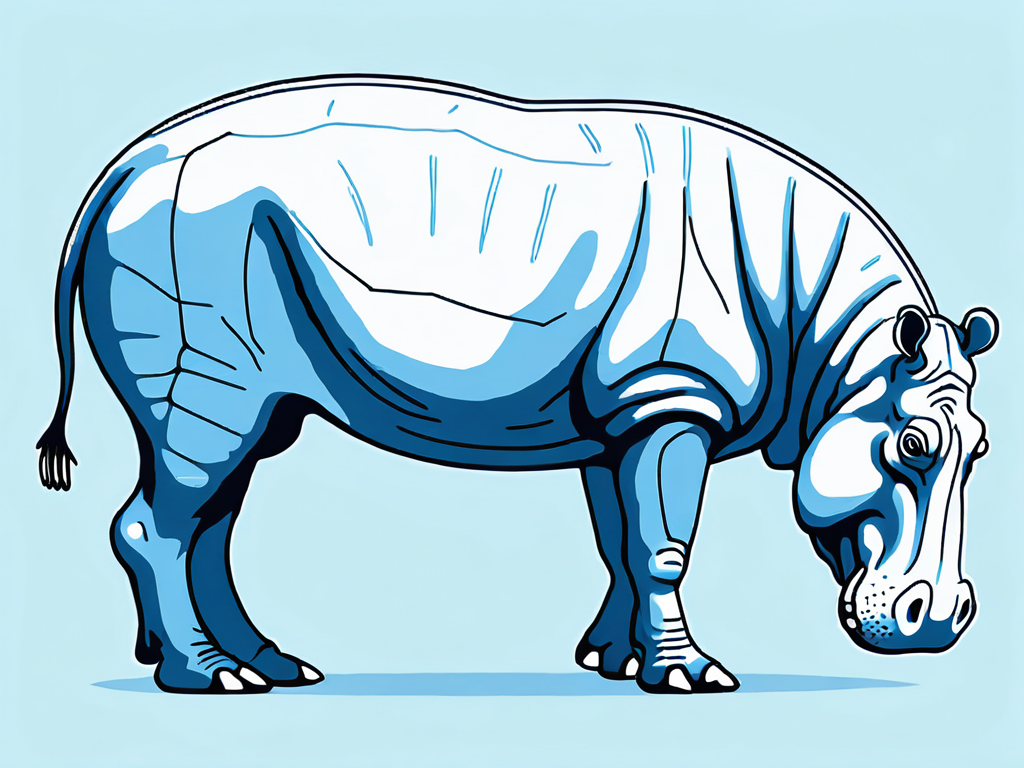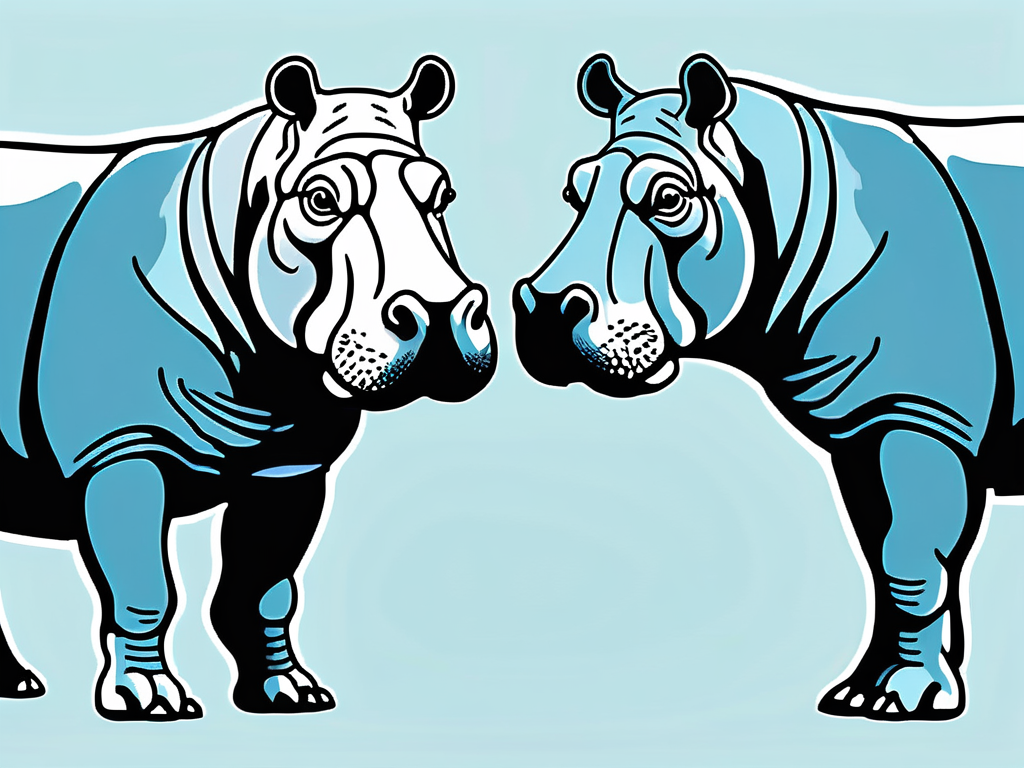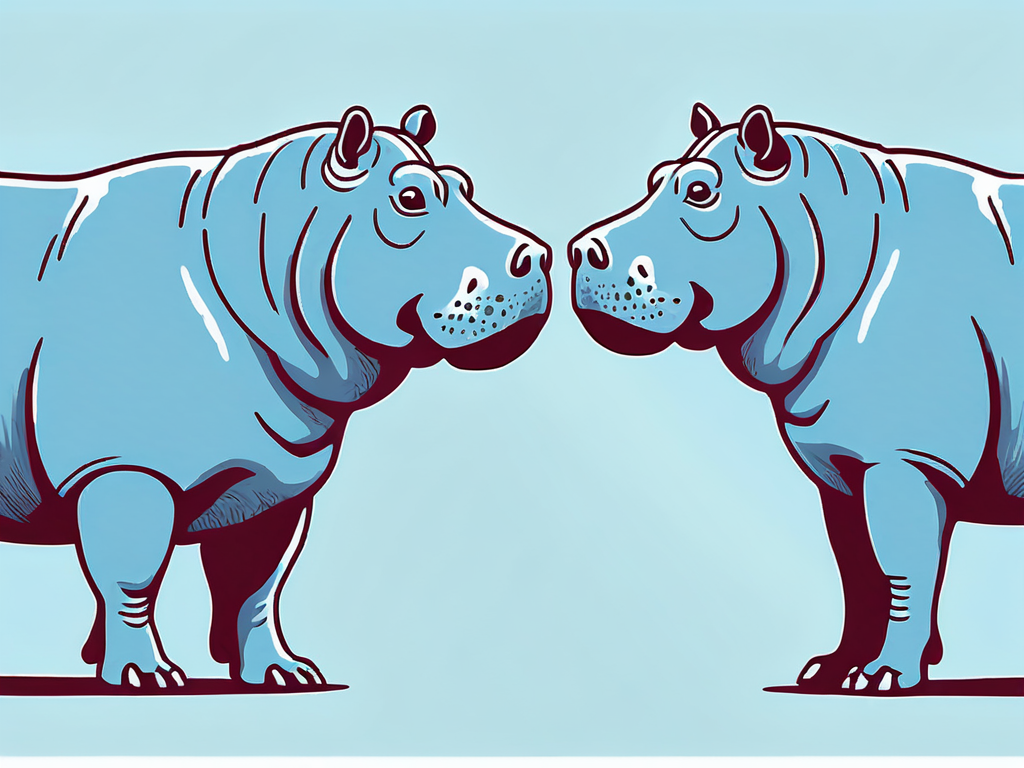When it comes to the anatomy of animals, there are some body parts that immediately catch our attention. And let's be honest, few body parts raise eyebrows quite like a hippo's butt or a dog's butt. But why are these derrieres so fascinating? What purpose do they serve? In this article, we will dive deep into the world of hippo and dog butts, exploring their anatomy, functionalities, evolutionary aspects, and the impact of the environment. So brace yourself for a wild and cheeky ride!
Understanding the Anatomy of a Hippo Butt
First things first, let's take a closer look at the magnificent hippo butt. When it comes to size and shape, the hippo definitely takes the cake. With its large and round rear end, the hippo butt is an impressive sight in itself. But what exactly is the role of this prominent posterior for the hippo's survival?

Delving deeper into the world of hippo anatomy, it's fascinating to note that the hippo's butt is not just a random chunk of flesh. It is composed of thick layers of adipose tissue, which not only provide cushioning for the hippo's bones when it sits or lies down but also act as a buoyancy aid when the hippo is submerged in water. This unique adaptation allows hippos to effortlessly glide through rivers and lakes, showcasing the evolutionary marvel of their behinds.
The Size and Shape of a Hippo Butt
The size of a hippo butt is truly awe-inspiring. It can weigh up to several hundred pounds and measure several feet in diameter. This massive size not only helps the hippo maintain balance and stability while navigating through water and land, but it also serves as a means of storing fat reserves, crucial during times of scarcity. In the world of hippos, big butts are definitely a desirable trait!
Moreover, the shape of a hippo butt is not just for show. Its roundness and bulkiness are essential for thermoregulation, especially in the scorching African sun. The ample surface area of the hippo's butt allows for efficient heat dissipation, preventing overheating and ensuring the hippo remains cool even in the hottest of climates. So, next time you see a hippo basking in the sun, appreciate the functional beauty of its well-rounded rear end!
The Role of a Hippo Butt in its Survival
But a hippo's butt is not just about size and aesthetics. It plays a vital role in the social dynamics of these magnificent creatures. When male hippos engage in territorial battles, they use their butts to intimidate rivals. They swivel their hefty posteriors, wagging them aggressively to assert dominance. It's like a hipposized version of "shake what your mama gave you!"
Furthermore, the hippo butt is a key player in communication within hippo pods. By wiggling, lifting, or even defecating with their butts, hippos can convey important messages to other members of their group. This unique form of non-verbal communication helps maintain social cohesion and hierarchy within the pod, showcasing the multifaceted nature of the hippo butt beyond its physical attributes. So, next time you observe a group of hippos interacting, pay attention to the subtle movements of their behinds - it's a whole new world of hippo communication!
Delving into the Dog Butt
Now that we've explored the wonders of the hippo butt, let's switch gears and focus on man's best friend – the dog. Although significantly smaller than a hippo, a dog's butt is equally fascinating in its own right. So, what makes a dog's behind so unique?
When we delve into the intricate details of a dog's anatomy, we discover a world of marvels. Beyond the wagging tail and cute wiggles lies a complex network of muscles that give a dog's butt its remarkable flexibility and agility. These muscles not only allow dogs to perform impressive feats of athleticism, such as leaping and running with grace, but also play a crucial role in their overall balance and coordination.
The Unique Characteristics of a Dog Butt
One of the most notable characteristics of a dog's butt is the wagging tail. This lively appendage serves as a communication tool, expressing a range of emotions from excitement to happiness or even nervousness. It's like a wagging flag, broadcasting a dog's innermost feelings to the world. And let's not forget about those adorable butt wiggles when our furry friends are really excited - it's like their whole butt is doing a dance of joy!
Moreover, a dog's butt is not just a functional body part; it is also a canvas for artistic expression. Dog owners around the world have embraced the trend of "doggie tattoos," where intricate designs and patterns are shaved into the fur around a dog's butt. From paw prints to geometric shapes, these creative grooming styles add a touch of flair and personality to our canine companions, turning their behinds into miniature works of art.
The Functionality of a Dog Butt in Canine Behavior
A dog's butt is not just for wagging tails and cute wiggles. It also plays a crucial role in their communication and social interactions. The anal glands located near the dog's anus release scent markers, which function as a doggie calling card. These scent markers are their way of saying, "Hey, I've been here!" Whether it's claiming territory or leaving a message for other dogs, a dog's butt holds a wealth of olfactory information.
Furthermore, a dog's butt serves as a barometer of their health and well-being. Veterinarians often examine a dog's rear end as part of a routine check-up to assess the condition of their anal glands and overall digestive health. By paying attention to any changes or abnormalities in this area, pet owners can ensure that their furry friends stay happy and healthy for years to come.
Comparing the Physical Features
Now that we've explored the unique aspects of hippo and dog butts individually, it's time for a side-by-side comparison. Let's see how these two posteriors stack up against each other in terms of size and shape.

Size Comparison: Hippo Butt vs Dog Butt
When it comes to size, there's no contest. Hippo butts reign supreme, with their massive dimensions dwarfing even the biggest dog butts out there. While a dog's butt can vary in size depending on the breed, they pale in comparison to the grandeur of a hippo's posterior. It's like comparing a Mini Cooper to a monster truck!
But let's delve deeper into the sheer magnitude of a hippo's behind. These majestic creatures, known for their hefty bodies, possess buttocks that can weigh up to hundreds of pounds. The sheer volume of a hippo's rear end is not just for show; it serves a vital purpose in providing buoyancy and stability as they navigate through the water. In contrast, a dog's butt, while undoubtedly adorable, is designed more for agility and quick movements rather than sheer size and weight.
Shape Comparison: Hippo Butt vs Dog Butt
Shape-wise, the differences are quite striking as well. A hippo butt is round and curvaceous, resembling a giant donut or a buoy floating in the water. On the other hand, a dog's butt is more streamlined and compact, reflecting the athleticism and maneuverability of our furry companions. It's like comparing a sumo wrestler to an Olympic sprinter!
Furthermore, the unique shape of a hippo's butt plays a crucial role in its survival. The rounded contours not only store layers of fat for energy reserves but also aid in regulating body temperature. In contrast, a dog's butt, with its sleek and tapered form, allows for swift movements and quick reflexes, essential for hunting and play. Each shape is perfectly adapted to the lifestyle and habitat of these fascinating creatures, showcasing the wonders of evolution at work.
Comparing the Functionalities
Now that we've examined the physical aspects, let's delve deeper into the functionalities of these magnificent backsides. What purpose do they serve for their respective owners?
Understanding the functionalities of animal behinds can offer fascinating insights into their daily lives and behaviors. Let's explore further the intricate roles that these rear ends play in the animal kingdom.
Role Comparison: Hippo Butt vs Dog Butt
When it comes to functionality, the hippo butt and dog butt have distinct roles to play. For a hippo, their butt is not only a symbol of power and dominance, but it also serves as a cushion while sitting or resting. Their massive rear end provides much-needed comfort in their watery habitats. Additionally, the hippo's butt plays a crucial role in communication within their social groups, as specific postures and movements can convey messages of aggression or submission.
On the other hand, a dog's butt is a versatile tool for communication, expressing emotions through tail wagging and leaving scent markers for their fellow four-legged pals. The position of a dog's tail can indicate various moods and intentions, allowing for subtle but effective ways of conveying messages to other dogs and even humans. Moreover, the glands located in a dog's anal region release unique scents that serve as a form of identification and territory marking, essential for social interactions in the canine world.
Evolutionary Aspects of Hippo and Dog Butts
Now, let's take a step back in time and explore the evolutionary purpose behind these intriguing rear ends. How did they develop over time? Let's find out!

When delving into the evolutionary history of hippo and dog butts, it's fascinating to uncover the intricate adaptations that have taken place over millions of years. These seemingly mundane body parts hold a wealth of evolutionary significance that sheds light on the survival strategies of these animals.
Evolutionary Purpose of Hippo Butt Features
Throughout evolution, a hippo's butt has adapted to the unique challenges of their semi-aquatic lifestyles. The large size and round shape provide buoyancy in water, enabling them to glide effortlessly through rivers and lakes. Additionally, their fat reserves stored in their butts serve as a survival mechanism during times of scarcity. It's like nature's way of saying, "I've got your back...or rather, your butt!"
Moreover, the skin of a hippo's butt is not just a layer of protection; it also secretes a natural sunscreen-like substance that helps shield them from the harsh African sun. This adaptation showcases the intricate ways in which evolution has equipped hippos to thrive in their specific environment, highlighting the interconnectedness of anatomy and survival.
Evolutionary Purpose of Dog Butt Features
Similarly, a dog's butt has undergone evolutionary changes to cater to their social and communication needs. From the wagging tail to the scent markers, these features have developed over time to enhance their interactions with other dogs and humans. It's like a non-verbal language that dogs have mastered throughout their journey alongside human civilization.
Furthermore, the positioning of a dog's anus plays a crucial role in their communication with other canines. By presenting their rear end in different ways, dogs can convey a myriad of messages, from submission to assertiveness. This evolutionary adaptation highlights the importance of body language in the intricate social dynamics of dog packs, showcasing how even the subtlest of anatomical features can have profound implications in the animal kingdom.
The Impact of Environment on Hippo and Dog Butts
Now that we've explored the physical and evolutionary aspects, it's time to consider the impact of their environment on these unique buttocks.
How the Environment Shapes the Hippo Butt
The aquatic environment in which hippos reside has played a vital role in shaping their backsides. The propensity of hippos to spend a significant portion of their lives submerged in water has led to the development of their massive, buoyant butts. It's like a natural adaptation that allows them to be kings and queens of the water world, ruling with their mighty derrieres!
Furthermore, the muddy banks and riverbeds where hippos often bask under the sun also contribute to the unique shape of their butts. The constant exposure to sun and water creates a perfect environment for the growth of algae and other microorganisms on their skin, giving their behinds a distinctive hue and texture. This symbiotic relationship between hippos and their environment not only affects their appearance but also plays a crucial role in thermoregulation and protection against the harsh African sun.
How the Environment Influences the Dog Butt
For our canine companions, the environment has a different impact on their rear ends. Dogs have evolved alongside humans, adapting to various environments and lifestyles. From the working dogs herding livestock to the pampered pooches living in luxury, the environment shapes their behaviors and, consequently, their butts. It's like a versatile canvas where nature and nurture paint a picture of wagging tails and butt sniffs.
In urban environments, where dogs navigate concrete jungles and crowded streets, their butts may develop calluses from constant friction against hard surfaces. On the other hand, dogs living in rural areas may have more muscular and toned buttocks from running across fields and rough terrains. The diversity of environments in which dogs thrive showcases the adaptability and resilience of these loyal companions, as their butts mirror the challenges and comforts of their surroundings.
Expanding on the topic of animal rear ends, it's worth delving into the evolutionary significance of these anatomical features. The hippo's butt, for example, plays a crucial role in its aquatic lifestyle. Not only does it provide buoyancy and streamline the hippo's movement in water, but it also serves as a means of communication. Hippos use their rear ends to mark territory by spraying feces with their tails, a behavior known as "dung showering." This unique form of communication helps establish dominance and maintain social hierarchies within hippo groups.
On the other hand, the dog's butt, specifically its tail, is a multifunctional appendage that serves various purposes beyond just wagging in excitement. A dog's tail is a key element of its body language, conveying emotions such as happiness, fear, or aggression. Additionally, the position and movement of a dog's tail can indicate its level of alertness and willingness to interact with other animals or humans. Understanding these subtle cues can enhance our communication and bond with our canine companions, allowing for more meaningful interactions and a deeper appreciation of their expressive rear ends.
In essence, the hippo butt and the dog butt are not just random body parts but intricate components that play essential roles in the lives of these animals. By recognizing and celebrating the unique functions and behaviors associated with these rear ends, we gain a deeper insight into the fascinating world of animal anatomy and behavior. So, next time you encounter a hippo or a tail-wagging dog, take a moment to marvel at the complexity and beauty of their posterior features, appreciating the evolutionary marvels that have shaped these remarkable creatures.
Unleash Your Inner Baker with BakeMeMate!
As we've explored the charming world of hippo and dog butts, why not bring a touch of this whimsicality into your kitchen? BakeMeMate invites you to express your love for these adorable animal behinds with our Hippo Butt Cookie Cutters. Perfect for any occasion, our cookie cutters are sure to spark joy and giggles at your next baking session. If you have a custom design in mind, we're all ears – your input is what helps us create the perfect cookie cutter! Quality and customer satisfaction are our top priorities, so visit us at BakeMeMate and let's bake some fun together!

